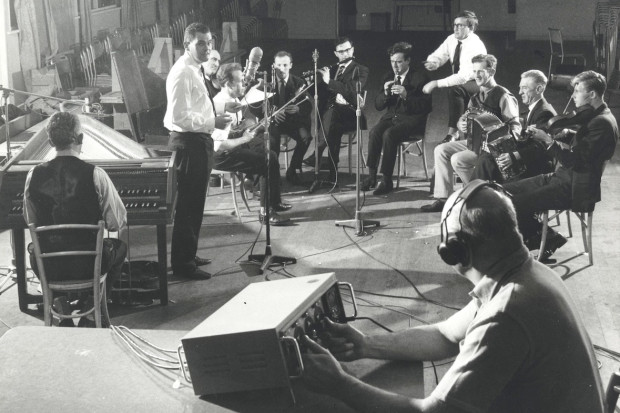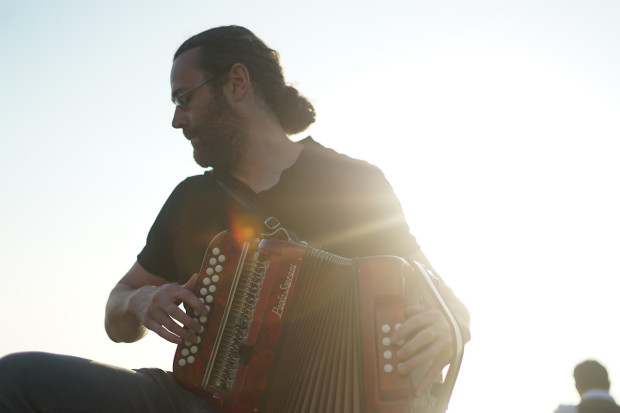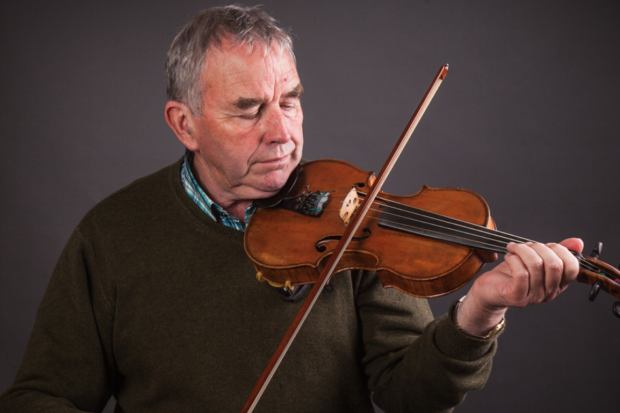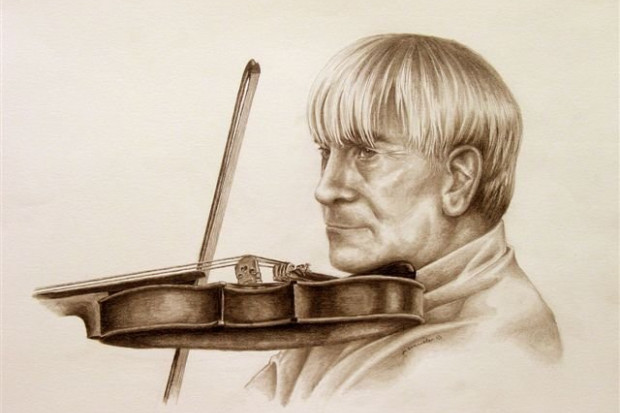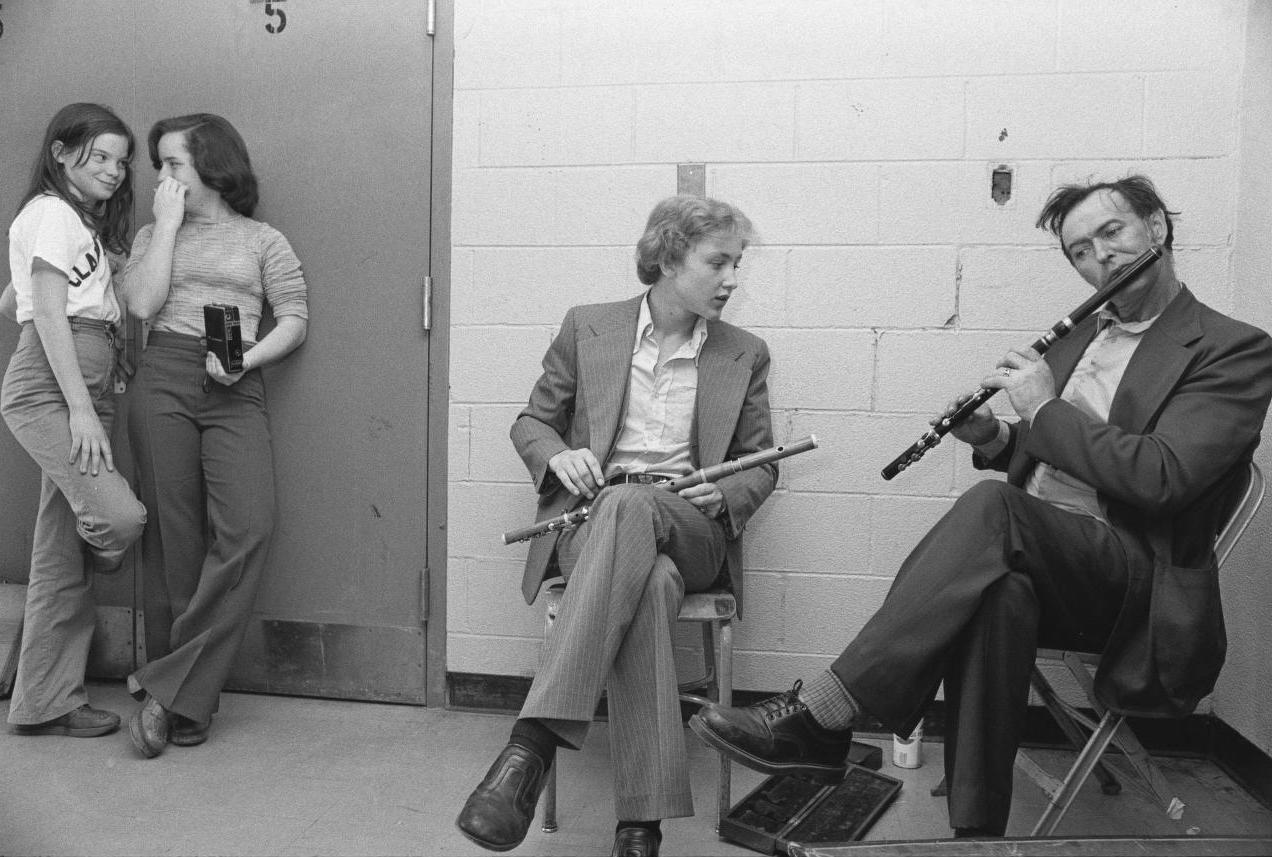
Michael Flatley and Kevin Henry at the Annual Midwest Fleadh Cheoil, Bogan High School, 79th and Pulaski, Chicago on 8 May 1977 (Photo: Jonas Dovydenas; Collector: Mick Moloney; Courtesy of Chicago Ethnic Arts Project, Library of Congress).
An Incomplete Journey Through Chicago's Irish Music Scene
In 1981 I was in my final year of undergraduate study at the University of Chicago, in Hyde Park on the shores of Lake Michigan on the south side of the city. I was born twenty years earlier about twenty blocks south of Hyde Park, of Irish immigrant parents, though we had left the ‘South Side Irish’ community before I was of school age. My parents encouraged their children to play and dance, no matter where their lives took us, to southern Indiana and eventually to Wisconsin. I had been recruited into an Irish band comprised of University of Chicago grad students. One of the band’s guitarists was Dan Dick, who was also working on his flute playing. Dan had found a flute mentor in Kevin Henry, the renowned musician, singer and storyteller. Kevin was a member of the Irish Musicians Association of America, founded in the late 1950s by immigrant musicians in Chicago, with members in Philadelphia and New York. At the time they met monthly at the Glendora House, a venue for dances and weddings, out beyond the southwest boundary of the city. The committee usually dispensed with its business quickly, and as most of them were musicians, a session would follow. The legendary fiddler Johnny McGreevy was usually there, and Kevin with his flute, and some box players. Dan had been out there before, and one month he offered to take me along. We headed off in his car from Hyde Park full of anticipation.
The evening turned out badly for all concerned. At the meeting, tensions that had apparently been simmering silently for some weeks exploded. The association had nearly finished an ambitious project to produce a recording of its members, on which Kevin had brought Dan in to record guitar accompaniment on a few tracks. There was apparently some tension over who should and should not be included on the album. The association had recently folded itself into Comhaltas Ceoltóirí Éireann, and this too was a source of disagreement. A fuse was lit when the next order of business was to agree to place the CCÉ logo on the cover of the album. We were sitting at some distance from the table, waiting for things to wrap up, not quite hearing what was being said. Then Kevin’s piercing voice rang out: ‘You’ll not put that swastika on my back!’ Michael Flatley Sr, father of the world-famous dancer, was in the chair. Somehow, he steered the meeting to an inconclusive end. Everyone left in silence. There were no tunes. We drove all the way back to Hyde Park, dejected but also somewhat bemused.
Musical richness
That busted expedition was the first of many glimpses I got into the musical world of Irish Americans in Chicago over the next few years. I was burning with curiosity about this world. From my perspective in Hyde Park it looked like a kind of alternate reality I might have inhabited had my parents, like their sisters and brothers, stayed and raised their children on Chicago’s south side. My exposure to the traditional musicians in Chicago in the early 1980s instilled in me an ambivalent kind of longing that remains lodged in my heart. Ambivalent in the sense that while intellectually and culturally that community seemed conservative and claustrophobic to me, I was nevertheless completely captivated by the musical richness of this culture and I wished desperately to be a part of it. There was an astounding depth of talent in the generation of Chicago musicians arriving into adulthood along with me. Meeting and listening to soon-to-be-influential players like Liz Carroll (fiddle), Jimmy Keane (piano accordion), John Harling (whistle) and John Williams (accordion and concertina), who appeared to have the entirety of Captain Francis O’Neill’s collections in their heads, were masters of the repertoire of newly composed tunes from Ed Reavy, Larry Redican, Paddy O’Brien, Paddy Fahey and others, were already composing tunes of their own that would be played in sessions across the globe in the coming decades, and who had incredible style and chops to boot – all this lit a fire in me that has been raging for four decades. And while the music of the older generation sometimes sounded a bit slack and conservative – one regularly encountered sessions populated by an army of Paolo Soprani accordion players stumbling through their narrow selection of well-worn tunes – I realised soon enough that the new generation was standing on the shoulders of giants: the kind-hearted and sublime fiddler McGreevy, virtuoso piper Joe Shannon, Jimmy (fiddle) and Eleanor Kane Neary (piano), Seamus and Joe Cooley, concertina player and composer Terence ‘Cuz’ Teahan, and of course the enigmatic Henry.
Fanning the flames
The appearance of Richie Piggott’s massive and ambitious The Cry of a People Gone: Irish Musicians in Chicago, 1920–2020 fans the flames of this fire. Piggott’s book opens a window onto the world of these giants, and their entire cohort of Irish immigrant musicians of the 1950s. Piggott clearly has a deep passion for preserving their lives in memory, and an unquenchable appetite for research into their lives. His research includes many very hard to find sources, and he has been in personal communication with dozens of musicians currently living in Chicago, and some who have recently passed away. The index of musicians profiled or discussed in the book has over two hundred and seventy names. The book is also embellished with a well-nigh uncountable number of historic photographs. The author promises to extend the four hundred hundred pages of material in this book to a website and YouTube channel that are to hold rare and forgotten commercial recordings and other digitised sound material, all under the umbrella of Cnocangle Productions, apparently his own company.
Cry of a People Gone unfolds chronologically, beginning with a short chapter on Chicago’s nineteenth-century origins, skipping over the life and times of Captain O’Neill (perhaps because this period has been covered by a number of scholars). The first substantial chapter covers the post-O’Neill generation in the 1920s and 1930s, and this is followed by another substantial chapter on the new Irish immigrant musicians after World War II, divided geographically into the two areas of their settlement in the city, the south side and the west/north side. These chapters follow the structure (if not the inimitable style) of O’Neill’s famous Irish Minstrels and Musicians. The final chapters of the book cover the founding of the above-mentioned Irish Musicians Association of America (IMA) in Chicago in 1956, the 1959 tour of Ireland by Irish American musicians organised by IMA founder and flute player Frank Thornton, and the fleadheanna cheoil organised by the IMA in the mid-1960s. These last chapters are essentially photographic scrapbooks, thin on text but rich in visual imagery.
The book is dedicated to the ‘lesser known players, and the secret players that we probably won’t ever hear a word about who were at the heart of the tradition and kept its spirit alive.’ Piggott has clearly strived for exhaustive inclusivity, particularly regarding the 1950s immigrant generation. A vast ocean of biographical detail on dozens of individuals is presented, but the subjects of his accounts are necessarily not particularly secretive. They were after all seen and heard in public, recorded and photographed, remembered in the community for their performances in living rooms, church basements, concerts, competitions, ballrooms and taverns. We find out about the violinist and publisher Selina O’Neill, no relation to Francis but very important to the extension of his legacy in to the twentieth century. Readers with a special interest in the story of the uilleann pipes and pipers in America will find information about Patrick Hennelly, player and maker of uilleann pipes, father and son pipers John and Tom Ennis, the instrument of nineteenth-century piper John Beatty, and the virtuoso piper Joe Shannon. Because Shannon played a set of pipes made by the Taylor brothers of Philadelphia, there is a long digression about these elusive siblings, innovators of the modern wide-bored ‘concert’ uilleann pipes, and Patrick Brennan, another Philadelphia pipe maker, pulling the independently wealthy Pennsylvania ceramicist and folklorist Henry Chapman Mercer into the story.
Readers are rewarded with many insights into the trajectories of a host of musical lives, and an appreciation of how music making supported individuals and strengthened the Irish community. For example, in the inspiring account of the life of Frank Burke, we get to know a lapsed fiddler who, in 1970 at the age of 40, through the generosity and encouragement of McGreevy, slowly rebuilt his skills and spent the next five decades playing sessions and functions on the south side until his death in 2018. Tom O’Malley, another lapsed musician, was similarly nurtured back to a performance standard by Teahan and played his accordion in pubs and dance halls for many years thereafter. The book also highlights the lives of ‘four wonderfully proficient female piano players’ of the post-war period, all of whom played melodies at dance tempo with their right hand on the keyboard: Eleanor Kane Neary, Nancy Harling, Maisie Mitchel and Mary MacDonagh.
Shortcomings
Cry of a People Gone is however a very frustrating read with serious shortcomings. Piggott is a food scientist working for the Kerry Group in Chicago applying his expertise in enzymes to problems such as burger bun ‘resilience’. He is neither a musician nor a musicologist, a historian neither of Chicago nor of Irish America, nor is he a particularly skilful writer. However, this lack of qualifications is no excuse for the unprofessional, careless and often nonsensical way in which the material has been written up. We can begin with the title, taken from a poem about Clare whistle player Micho Russell by Donal Ó Siodhacháin called ‘The Soul of Clare’, which ends with ‘Micho singing the soul of Clare / and the cry of a people gone.’ Aside from having no particular relevance to Chicago, the sentiment conveyed does not seem apt. Would it not be more appropriate to have Micho singing ‘the cry of the people who stayed behind’? Consider the reflections of London immigrant Brian Behan:
But then, no young man or woman is sorry to go. The only ones I ever saw weeping were those left behind… I tried to feel sad that I was leaving my haunts behind, but I didn’t, and then I felt ashamed because I didn’t. Then I got fed up feeling ashamed and wished to Christ that the bloody boat would push off and let me get to hell out of there. (Brian Behan, With Breast Expanded, London, 1964)
My point is that nobody is crying in Piggott’s account of Irish American lives, packed as it is with photos of smiling, well-dressed musicians clearly enjoying themselves. In sketch after sketch, the subject ‘got employment straight away’, ‘got a job shortly after his arrival’, and ‘immediately fell into’ the music scene upon arrival in Chicago. But were there really no tears at all? Everyone lands in to the happy world of playing music without any tensions or frictions. Nobody is excluded, there is no hint of the cultural tensions between the new immigrants and the established Irish American community, no rivalries between immigrants from different parts of Ireland, no disputes about how musical activity should be organised (such as the one described above), no musical tensions between generations, or between Irish musicians and non-Irish people who aspire to play Irish music.
If the title is confusing and misleading, the subtitle is even more so: Irish Musicians in Chicago 1920–2020. The beginning and end dates appear to have been randomly selected, and have little relevance to the actual contents of the book, which starts with ‘early Chicago’ of the nineteenth century and vaguely trails off sometime in the 1970s. Without insisting on the highest academic standards, one might have expected the author to have at least explored the scholarship required even of an undergraduate essay on Irish American culture in the twentieth century, such as Kerby Miller’s indispensable Emigrants and Exiles: Ireland and the Irish Exodus to North America (New York, 1985), or Kevin Kenny’s The American Irish: A History (New York, 2000), or Lawrence McCaffrey’s collection The Irish in Chicago (Chicago, 1987), not to mention all the relevant research published over the years in the premier journals of Irish studies in the United States, Éire/Ireland and New Hibernia Review (see the material collected by James Rogers and Matthew O’Brien in After the Flood: Irish America, 1945–1960 (Portland, Oregon, 2009)). Had Piggott done so, the reader might have been given some coherent context and periodisation. For example, we might better understand the apparently relentless happiness of the 1920s, 50s and early 60s. After all, these were some of the most buoyant decades in the history of capitalism. Combine this with the strong grip the Chicago Irish American community had established on the political and economic infrastructures and networks of the city and one might understand how so many thousands of Irish landed so easily on their feet in Chicago. But the reader also gets no sense of the eventual fragility of these infrastructures and networks. When I was born in 1960, my father was working at United States Steel South Works, a massive operation that was still employing more than ten thousand people, thousands of them Irish, in 1970. Twenty years later it had only about seven hundred employees. Thirty years later it had been completely demolished. The author defines ‘The Irish Southside’ as ‘extending from Lake Michigan to Pulaski (E. to W.) and from 55th to 87th (N. to S.)’, but by the 1980s the Irishness of these streets was rapidly collapsing. Today, the south side sessions are now far to the south of this rectangle, and Irish Americans are thinly distributed across a sprawling exurbia extending north nearly to Wisconsin and west out to the Fox river valley. Attending a session in Lanigan’s Bar on 111th and Western (where many of Piggott’s most prized sources had been meeting up for tunes until their recent deaths in the last few years), or Clancy’s Pizza Bar in a strip mall at 103rd and Cicero, you might meet musicians who have travelled two hours or more on the suburban freeways to get there.
Post-1976
The year 1976 would have been a more appropriate end date for Piggott’s subtitle than 2020. That was the year the politician Richard Daley died, signalling the beginning of the end of the Irish political machine, of industrial Chicago, and of the Irish American neighbourhoods inside the city’s boundaries. It would also be more appropriate because Piggott is clearly not interested in the lives the Chicago Irish musicians who were in their teens in 1976 have lived, nor in the deeply significant impact they have had on Irish music across America and beyond. This would necessarily bring him into ‘foreign’ territory, because the musicians he cares about were losing their grip on a session scene that was more and more multi- or post-ethnic. At the same time, they were being musically surpassed by innovative professionals who don’t fit into the Hanley’s House of Happiness (a south side music tavern) accordion player mould. One thinks, in addition to those already mentioned, of innovative guitarists like Mike Kirkpatrick or Dennis Cahill, both of whom passed away far too young and are not remembered in this volume.
Early in the book, Piggott describes the sponsorship of a second Irish Village at the 1934 Chicago World’s Fair by some local Irish American investors; ‘Unlike the Irish State-sponsored exhibit, the Irish Village was badly organised and hastily put together.’ Piggott also quotes a review in the Illinois Society of Architects Monthly Bulletin which called it ‘an amateurishly conceived conglomeration of historical landmarks.’ Something similar could be said of Cry of a People Gone. Even in its most valuable core sections, comprised of biographies of musicians who were already in Chicago before World War II and those who arrived in the decades following it, the book is lacking in narrative coherence and stained by editorial sloppiness. It appears as if, when sitting down to write up his information on a particular individual, Piggott had forgotten what he wrote previously about someone else. People are referred to as if they have been introduced previously when they haven’t, and later referred to as if they haven’t been introduced when they have. Particular events, anecdotes and locations are described repeatedly, and quite a few photographs are presented more than once. Everything and everybody is included, no matter their significance or relevance. The chapter on early Chicago includes material about emigrants to Neenah, Wisconsin, for no apparent reason other than the author found some letters in a Wisconsin library. Piggott devotes twelve pages to reproducing a single immigrant’s letter in its entirety. A letter from the odious Michael Pence, former vice president of the United States, is reproduced. Major figures such as Joe Shannon end up being given the same importance as entry number 46 in the appendix of accordion players. (And why is there no appendix of flute players or fiddlers, or singers? Why have we no account of the deeply influential schools of dance in Chicago, without which we would never have heard of Michael Flatley, and the dance feiseanna where these schools competed against each other and the accompanying musicians honed their rhythmic skills?)
Biographical sketches
In light of these weaknesses, the reader is probably better off dipping in and out of the book, and I expect this is how most will engage with it, especially those from Chicago who already know something of the people and places. Nearly every biographical sketch begins with marriages and births, dates of passage across the Atlantic, addresses in Chicago, and so on. Much of what is presented about individual musicians will not be of interest beyond their circle of surviving friends and relations, even for historically significant individuals. Who, for example, aside from his grandchildren, wishes to know who were the witnesses to Shannon’s parents’ wedding in Kiltimagh, Co. Mayo, in 1897? A yet more significant question, and not just for friends and relations, is: how do we know these facts are true? Paragraph after paragraph of factual information is backed up with footnotes of the form ‘Joe Bloggs, pers. comm., 2016.’ What is the nature of these personal communications? Did Piggott take notes, or make recordings? If so, where are these fieldwork artefacts held? If not, when he uses Joe Bloggs’ comments to write up a biography, did he check with Joe to see whether he had got the facts right? Piggott gets the year of Kevin Henry’s death wrong (it was 2020, not 2019). In a book of this scale there are bound to be mistakes like this, but how many? The problem is equally serious with regard to photographs and their captions. Under an undated photograph showing Keane, Carroll, flute player Noel Rice and three others lined up performing in front of microphones, the caption reads ‘Noel (playing flute) with some of his students including Jimmy Keane and Liz Carroll’. But Keane and Carroll were never students of Rice. So what was really happening in this photo? When and where was it taken? Did the author check with Keane or Carroll to find out?
A related and very serious weakness of the book is that Piggott has done the absolute minimum to record the provenance of the photographs. There is a list of names under the heading ‘Photograph Credits’ in the back pages, leaving the reader with the hopeless task of guessing who might be responsible for what. Worse, this list is incomplete. One of the most evocative photographs in the book captures a young Flatley sitting, flute in hand, next to his hero Henry. The two men are sharply dressed and looking very relaxed with each other. Henry appears to be starting up a tune, and Flatley is looking on, his admiration and curiosity frozen in the image. Where was this photo taken and by whom? Who gave Piggott this photo? The answers, not to be found in the book, reveal something significant both about an important moment in the history of Irish music in Chicago and about how to document that history. The photographer, Jonas Dovydenas, was accompanying Mick Moloney on a Library of Congress funded collecting trip under the umbrella of the massive Chicago Ethnic Arts Project of the late 1970s. The pair had come to document the Chicago Fleadh held at Bogan High School on the south side in May of 1977. Dovydenas is not listed in the credits. Perhaps better known as a musician and promoter, Moloney was also an important music collector and a consummate professional in this field. He sadly passed away last year but left behind an important archive of images, interviews, and performance recordings in the Library of Congress and in New York University where he worked for many years. This Flatley/Henry photo (which incidentally has also been cropped from the original), is not the only photograph lifted from the Library of Congress in the book. Piggott is well aware of Moloney’s work, as he makes use of interviews Moloney conducted in Chicago in the late 1970s. Moloney’s field trips to Chicago are of historic importance in themselves, and they arguably should have formed a chapter of this book. More importantly, the way Moloney went about his business, and the careful way in which his work was documented and is preserved, should have served as a model for Piggott. It did not, but it is not too late. If, as the author promises, the book is only part of a larger project including a website (still empty at the time of writing), he has a chance to reorganise this material, get much needed editorial and fact-checking assistance, and properly document and display the massive archive in his possession. The possibility for a living and growing Wikipedia-style archive still exists. This would be the least the ‘lesser known players, and the secret players that we probably won’t ever hear a word about’ deserve.
The Cry of a People Gone: Irish Musicians in Chicago, 1920–2020 by Richie Piggott is published by Cnocangle Productions. To purchase a copy, visit www.richiepiggott.com.
–
The reviewer would like to acknowledge the work of historian Sarah S. Goek, whose PhD thesis Farewell to Erin: Oral Histories of Post-War Irish Music & Migration (University College Cork, 2015) reproduces the quote from Brian Behan above and provides rich detail on the life of Kevin Henry and other immigrant musicians.
Subscribe to our newsletter.
Published on 15 March 2023
Martin Dowling is a fiddle player and author of 'Traditional Music and Irish Society: Historical Perspectives' (Ashgate, 2014). He lives in Belfast.












